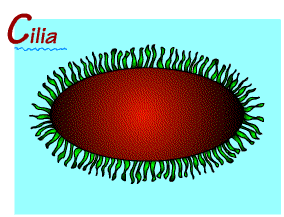What is Cilia and Flagella?
The surfaces of many eukaryotic cells bear cilia or flagella, built from specialized microtubules. Cilia are tiny brushlike hairs, and flagella are slender whiplike appendages used to push or pull the cell through a fluid environment, or to move the fluid surrounding the cell.
Cilia are generally short and present in great numbers. Their beat is oarlike. They are found in the human respiratory tract where they move the mucus that traps foreign particles and keeps them from reaching delicate lung tissue.

Whiplike flagella are much longer than cilia, and usually occur one or two per cell. In single-celled organisms, the flagellum carries out snake-like undulations, and in higher organisms, the flagellum moves fluid over the surface. Most sperm cells move by means of a single flagellum.
The typical cilium or flagellum is covered by a plasma membrane, and contains what is called a 9 + 2 arrangement of microtubules: nine fused pairs of tubules, called doublets, which form a cylinder, and one pair of unfused microtubules running up the center.
The motion of the cilium or flagellum results from the microtubules sliding past one another, using ATP for energy. At the base of the eukaryotic flagellum or cilium is an organelle called the basal body. The nine doublets extend into and are inserted in the basal body. Within the basal body, each doublet is joined by another microtubule, making nine sets of three microtubules. The central, unfused microtubules do not extend into the basal body.